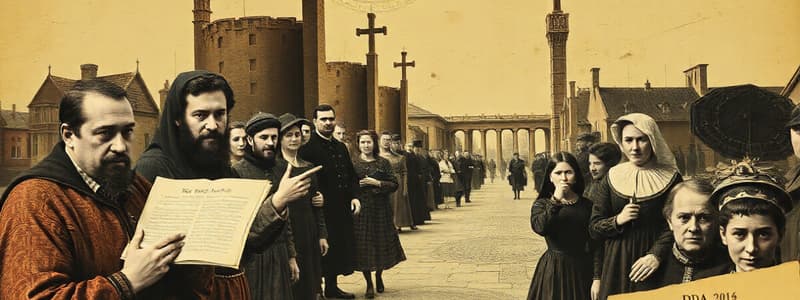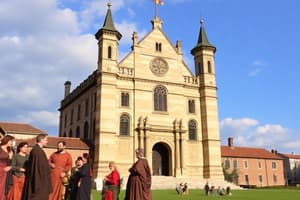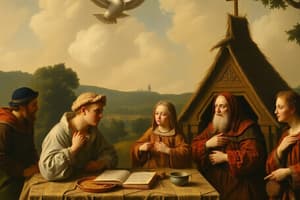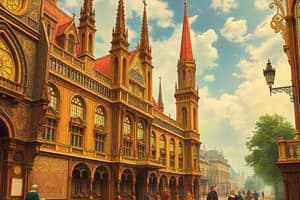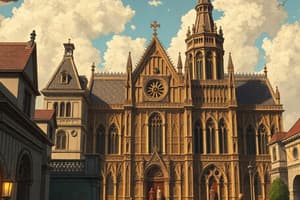Podcast
Questions and Answers
How did the invention of the printing press fundamentally alter the dissemination of knowledge during the Renaissance and Reformation?
How did the invention of the printing press fundamentally alter the dissemination of knowledge during the Renaissance and Reformation?
- By limiting access to knowledge to only the wealthiest individuals, reinforcing social hierarchies.
- By restricting the circulation of revolutionary concepts, in order to preserve social and governmental stability.
- By increasing the time required to produce written materials, thus preserving traditional methods of scholarship.
- By accelerating the spread of ideas and literacy through cheaper and more accessible books and pamphlets. (correct)
Which of the following best describes the key factors that enabled Italy to act as the birthplace of the Renaissance?
Which of the following best describes the key factors that enabled Italy to act as the birthplace of the Renaissance?
- Isolation from the rest of Europe, a lack of interest in classical learning, and a focus on religious piety.
- Thriving city-states, a wealthy merchant class, and access to classical heritage of Greece and Rome. (correct)
- A large peasant population, a powerful aristocracy, and limited contact with other cultures.
- A strong centralized monarchy, a unified cultural identity, and widespread agricultural prosperity.
In what way did Renaissance humanism reshape European intellectual and artistic norms?
In what way did Renaissance humanism reshape European intellectual and artistic norms?
- By advocating for a return to medieval scholasticism and the suppression of artistic innovation.
- By promoting a focus on worldly matters, individual potential, and classical values in education and art. (correct)
- By emphasizing the importance of religious dogma and rejecting classical sources of knowledge.
- By reinforcing the strict social hierarchies and the authority of the Church in all aspects of life.
What was the impact of overseas trade in the growth of city-states in Northern Italy?
What was the impact of overseas trade in the growth of city-states in Northern Italy?
How did the Renaissance alter the conventions of artistic representation, especially regarding perspective and realism?
How did the Renaissance alter the conventions of artistic representation, especially regarding perspective and realism?
How did Renaissance artists leverage classical themes and artistic conventions to challenge traditional medieval artistic norms?
How did Renaissance artists leverage classical themes and artistic conventions to challenge traditional medieval artistic norms?
In what ways did Renaissance society redefine the roles and expectations of women, particularly compared to the Middle Ages?
In what ways did Renaissance society redefine the roles and expectations of women, particularly compared to the Middle Ages?
What core tenets defined Martin Luther's challenge to the Catholic Church, and how did these catalyze the Reformation?
What core tenets defined Martin Luther's challenge to the Catholic Church, and how did these catalyze the Reformation?
What were the primary factors that motivated Northern European humanists to champion social reforms, and how did these reforms align with Judeo-Christian values?
What were the primary factors that motivated Northern European humanists to champion social reforms, and how did these reforms align with Judeo-Christian values?
How did the invention of the printing press affect the progress of the Reformation?
How did the invention of the printing press affect the progress of the Reformation?
What motivated German princes to support Martin Luther's teachings, and how did this patronage affect religious and political dynamics?
What motivated German princes to support Martin Luther's teachings, and how did this patronage affect religious and political dynamics?
How did the Peace of Augsburg seek to address the religious conflicts arising from the Reformation, and what long-term effects did it have on the Holy Roman Empire?
How did the Peace of Augsburg seek to address the religious conflicts arising from the Reformation, and what long-term effects did it have on the Holy Roman Empire?
What political motivations drove King Henry VIII of England to seek a break from the Catholic Church?
What political motivations drove King Henry VIII of England to seek a break from the Catholic Church?
What impact did Elizabeth I's reign have upon the religious landscape of England, and how did she navigate the challenges posed by both Catholics and radical Protestants?
What impact did Elizabeth I's reign have upon the religious landscape of England, and how did she navigate the challenges posed by both Catholics and radical Protestants?
How did John Calvin's theological doctrines differ from those of Martin Luther, particularly in the areas of predestination and salvation?
How did John Calvin's theological doctrines differ from those of Martin Luther, particularly in the areas of predestination and salvation?
What were the defining beliefs of the Anabaptists, their impact on religious tolerance during the Reformation given popular beliefs?
What were the defining beliefs of the Anabaptists, their impact on religious tolerance during the Reformation given popular beliefs?
What prompted the Catholic Church to initiate the Counter-Reformation, and what key measures defined this movement?
What prompted the Catholic Church to initiate the Counter-Reformation, and what key measures defined this movement?
How did the Council of Trent play a role in the Catholic Reformation, and what impact did its decrees and pronouncements have on defining Catholic doctrine?
How did the Council of Trent play a role in the Catholic Reformation, and what impact did its decrees and pronouncements have on defining Catholic doctrine?
How did the Renaissance contribute to atmosphere that encouraged religious reformation?
How did the Renaissance contribute to atmosphere that encouraged religious reformation?
In what ways did gender roles influence the Reformation? (Select all that apply)
In what ways did gender roles influence the Reformation? (Select all that apply)
How were the political dynamics of Europe affected because of the Reformation?
How were the political dynamics of Europe affected because of the Reformation?
What was the key legacy that stemmed out of the Renaissance?
What was the key legacy that stemmed out of the Renaissance?
How did the social, political, and economic structures in Europe encourage the movement of the Reformation?
How did the social, political, and economic structures in Europe encourage the movement of the Reformation?
In which artistic way did the Northern Renaissance differ from the Italian Renaissance?
In which artistic way did the Northern Renaissance differ from the Italian Renaissance?
Though many changes happened during the Reformation, what stayed the same?
Though many changes happened during the Reformation, what stayed the same?
How did humanism affect the values of society?
How did humanism affect the values of society?
Who was inspired by the words of Martin Luther?
Who was inspired by the words of Martin Luther?
What was the long-term consequence of the reformation that remains to this day?
What was the long-term consequence of the reformation that remains to this day?
How did the German princes' view the Pope?
How did the German princes' view the Pope?
What was the main impact by the invention of the printing press?
What was the main impact by the invention of the printing press?
What was the main focus in the artistic ideas that was spread?
What was the main focus in the artistic ideas that was spread?
What did Renaissance writers create that authors rely on today?
What did Renaissance writers create that authors rely on today?
Which of the following are the factors that caused the revolution in the Renaissance and Reformation?
Which of the following are the factors that caused the revolution in the Renaissance and Reformation?
Where did the word Humanist come from, and how did it transform society?
Where did the word Humanist come from, and how did it transform society?
What allowed the renaissance to spread, and why?
What allowed the renaissance to spread, and why?
Besides the Church, who else benefited from the arts financially?
Besides the Church, who else benefited from the arts financially?
Flashcards
What is the Renaissance?
What is the Renaissance?
A period of European history, roughly 1300-1600, marked by a revival of interest in classical art and learning.
What is humanism?
What is humanism?
An intellectual movement that focused on human achievements and potential.
What does 'secular' mean?
What does 'secular' mean?
Worldly rather than spiritual, focusing on the here and now.
Who is a patron?
Who is a patron?
Signup and view all the flashcards
What is perspective?
What is perspective?
Signup and view all the flashcards
What is vernacular?
What is vernacular?
Signup and view all the flashcards
What is a utopia?
What is a utopia?
Signup and view all the flashcards
Who was Johann Gutenberg?
Who was Johann Gutenberg?
Signup and view all the flashcards
What is an indulgence?
What is an indulgence?
Signup and view all the flashcards
What was the Reformation?
What was the Reformation?
Signup and view all the flashcards
Who is a Lutheran?
Who is a Lutheran?
Signup and view all the flashcards
Who were the Protestants?
Who were the Protestants?
Signup and view all the flashcards
What was the Peace of Augsburg?
What was the Peace of Augsburg?
Signup and view all the flashcards
What does 'annul' mean?
What does 'annul' mean?
Signup and view all the flashcards
What is Anglican?
What is Anglican?
Signup and view all the flashcards
What is predestination?
What is predestination?
Signup and view all the flashcards
What is Calvinism?
What is Calvinism?
Signup and view all the flashcards
What is a Theocracy?
What is a Theocracy?
Signup and view all the flashcards
Who were the Anabaptists?
Who were the Anabaptists?
Signup and view all the flashcards
What was the Catholic Reformation?
What was the Catholic Reformation?
Signup and view all the flashcards
Who were the Jesuits?
Who were the Jesuits?
Signup and view all the flashcards
What was the Council of Trent?
What was the Council of Trent?
Signup and view all the flashcards
Who was William Shakespeare?
Who was William Shakespeare?
Signup and view all the flashcards
Study Notes
European Renaissance and Reformation, 1300–1600
- The period from 1300 to 1600 in Europe, marked by cultural and religious changes
- Characterized by new ideas about art, culture, and religion
- Includes the Renaissance and the Reformation
Interaction and New Ideas
- Trade with the East and rediscovery of ancient manuscripts led to new European ideas
- The introduction of printing press allowed for faster and cheaper book and pamphlet production
- The new technology helped spread the revolutionary ideas of the Renaissance and Reformation
Renaissance
- A period called the Renaissance, meaning "rebirth"
- Originating due to increased trade with the East and rediscovery of ancient manuscripts
Martin Luther and the Reformation
- Discontent with practices of the Roman Catholic Church led Martin Luther to initiate change
- Martin Luther's movement to reform practices in the Catholic Church that he believed were wrong referred to as the Reformation
Renaissance Art: Rolin Painting
- Painting by Jan van Eyck, portrait of Chancellor Rolin
- Classical elements in the columns
- Use of perspective and oil paints
- Importance of religion shown through infant Jesus and Mary
- Emphasis on individuals, fur-trimmed robe indicating status
- Details added for beauty
Causes and Characteristics of the Renaissance
- Took place in Italy, movement lasted from approximately 1300 to 1600
- Renaissance meaning rebirth, as revival of art and learning
- Educated Italians hoped to revive culture of classical Greece and Rome, led to something new
- Italian advantages were thriving cities, a wealthy merchant class, and classical heritage of Greece and Rome
- Crusades spurred overseas trade which led to growth of Italy's northern city-states
- Northern Italy was urban and cities became ideal for intellectual revolution - Bubonic plague in the 1300s, killed up to 60% of the population - Created economic changes as survivors could demand higher wages
Renaissance Figures
- Belief in individual achievement became vital in the Renaissance
- Merchants dominated politics because they did not inherit authority, and used wits
- Medici family ruled Florence and Cosimo de Medici controlled Florence's government, influencing council members and his grandson Lorenzo also ruling
- Renaissance scholars wanted to return to the learning of the Greeks and Romans
- Scholars inspired by ruins of Rome and studied ancient Latin manuscripts, as Constantinople scholars fled to Rome with Greek texts in 1453
- Classics led scholars to humanism, an intellectual movement focused on human potential and achievements, humanities like history, literature, and philosophy
- People could enjoy worldly pleasures , and enjoy material luxuries, without offending God, Renaissance became worldly rather than spiritual and focused on here and now
Renaissance Men and Women
- Renaissance writers thought all educated people should create art, and idea individual known as a "universal man", excelling at any study e.g. Baldassare Castiglione's "The Courtier" - Young men should be charming, witty, educated, dance, sing, play music, and write poetry. - A young man should also be a be skilled rider, wrestler, and swordsman
- Upper-class women should know classics and be charming, inspire not create art
- Some women like Isabella d’Este ruled, brought artists to the court, building artworks, and being skilled in politics - Defended Mantua and won release after her husband was taken captive with many Renaissance artists present
Renaissance Art
- Artists used a realistic style from classical models in art, and classical ideas - Used technique of perspective to show three dimensions, also portrayed religious/Greek/Roman subjects
- Artists painted citizens to mark them and their characters, including painter/sculptor/architect/poet Michelangelo "Buonarroti" for human body/ Donatello for carving postures and expressions
- Leonardo da Vinci: painter, sculptor, inventor, scientist, studied workings, wrote backwards - Raphael: expressed calm and gentle scenes, filled Julius II's library such classical figures Michelangelo/ Leonardo - Anguissola & Gentileschi: Artists who made a mark, painting portraits and heroic images -Sofonisba Anguissola was first artist with international reputation
Renaissance Literature
- Writers reflected time and used present writing techniques like medieval writer Dante Alighieri "vernacular," native tongue - Petrarch: Influential in Renaissance humanism, written in Italian and Latin, sonnets/poems about his ideal Laura - Boccaccio: Writer of the Decameron in Florence, stories of people in rural place avoiding plague
Renaissance Politics
- The Prince (1513) Niccolo Machiavelli - the imperfect conduct of humans, political guide - Rulers to keep power regardless to enemies, must be strong and shrewd as fox - Leaders may be craftly to gain trust, must be feared more than loved
Renaissance Women
- Vittoria Colonna gained fame writing personal subjects and exchanged poems, sonnets with Michelangelo while others like Marguerite of Navarre supported Church reform
Renaissance - Global Patterns
- Several Renaissances at the time: Tang and Song dynasties in china- great artistic and technological accomplishments
Renaissance - The Northern Renaissance
- Renaissance ideas that expressed the northern tradition, human dignity brought some northern humanists to create social reform
Northern Renaissance
- Began spreading out into Europe in 1400s after Italian cities by northern Italy - Population increases during the time - Cities grew after 100 yrs war
- Monarchs sponsored the arts such as King Frances 1-invited Da Vinci and hired for architecture - Spread traditions throughout out other traditions
Northern Renaissance German Painters
- Albrecht Durer: Studied in Italy and created works of woodcuts and engravings, showing religious subjects which influence German art-
- Hanz Holbein: Specialized painting photographic details and portraits painted
- Jan Van Eyck help in Flanders that displayed realistic details to show ones personality
- Pieter Bruegel: Skillful with details using colors and balance
Reformation
- Martin Luther influenced writers examined classic thoughts that led the society to form the new christian humanism to change the world
- Desiderius Erasmus and Thomas More best Christians with "The Praise of Folly".
Renaissance writers/Thinkers
- Wrote Utopia, Greek for no place/ showed greek life and was translated in many different languages
Women Writers
- Christine De Pizan: Educated to be a write. wrote about reasons men would argue
The Elizabethan Age
- Shakespeare- influenced writings and worked to be display better communication, wrote poems, and drew inspiration for works and a deep understanding of human beings, Romeo & Julliet
Printing Spreads Renaissance Ideas
- Chinese invented block printing, Gutenberg created printing process after block printing. - Process: Printers produced thousand copies into a single works - Cheaper books started to produce
Legacy of the Renaissance
- Brought change by break with Medieval period which leads to belief in dignity during democratic ideas - Led to better works of art from Rome and Greece and portraying lifelike work.
Legacy of the Renaissance
- Brought change by break with Medieval period which leads to belief in dignity during democratic ideas - Led to better works of art from Rome and Greece and portraying lifelike work.
- Printing now made available and inexpensive towards societies such as accounts of the new and the humanities
Legacy of the Renaissance & Northern Renaissance
- Began in the 1400 in Northern region of Europe as writers examined and readdressed
- Art brought and expressed from Italian and Northern European and writers examine and create art.
- Spread to England in 15
Studying That Suits You
Use AI to generate personalized quizzes and flashcards to suit your learning preferences.
